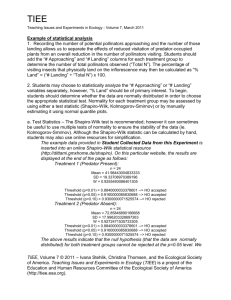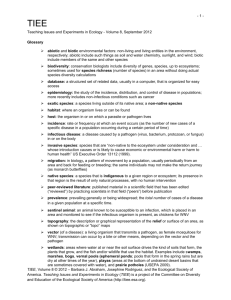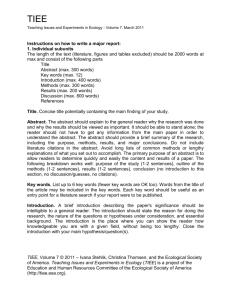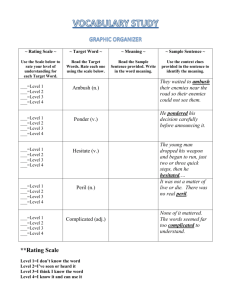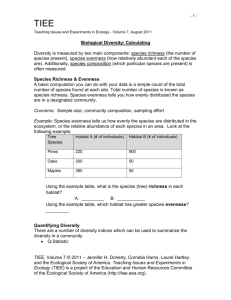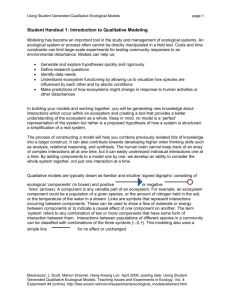stehlik_thomsen - Ecological Society of America
advertisement
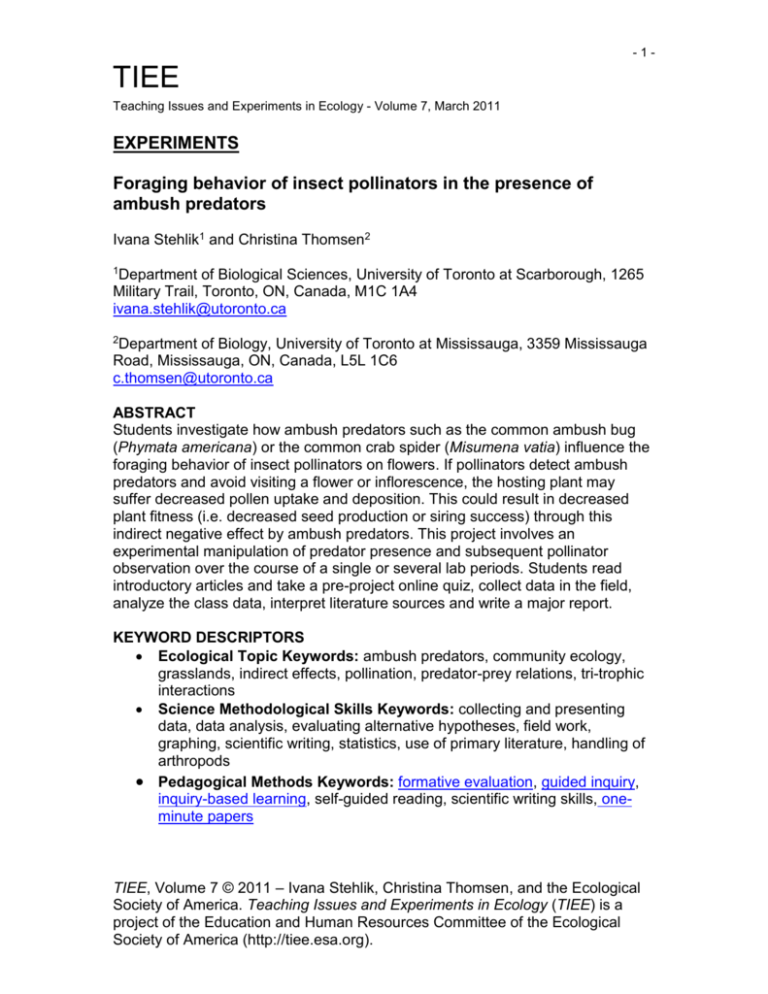
-1- TIEE Teaching Issues and Experiments in Ecology - Volume 7, March 2011 EXPERIMENTS Foraging behavior of insect pollinators in the presence of ambush predators Ivana Stehlik1 and Christina Thomsen2 1Department of Biological Sciences, University of Toronto at Scarborough, 1265 Military Trail, Toronto, ON, Canada, M1C 1A4 ivana.stehlik@utoronto.ca 2Department of Biology, University of Toronto at Mississauga, 3359 Mississauga Road, Mississauga, ON, Canada, L5L 1C6 c.thomsen@utoronto.ca ABSTRACT Students investigate how ambush predators such as the common ambush bug (Phymata americana) or the common crab spider (Misumena vatia) influence the foraging behavior of insect pollinators on flowers. If pollinators detect ambush predators and avoid visiting a flower or inflorescence, the hosting plant may suffer decreased pollen uptake and deposition. This could result in decreased plant fitness (i.e. decreased seed production or siring success) through this indirect negative effect by ambush predators. This project involves an experimental manipulation of predator presence and subsequent pollinator observation over the course of a single or several lab periods. Students read introductory articles and take a pre-project online quiz, collect data in the field, analyze the class data, interpret literature sources and write a major report. KEYWORD DESCRIPTORS Ecological Topic Keywords: ambush predators, community ecology, grasslands, indirect effects, pollination, predator-prey relations, tri-trophic interactions Science Methodological Skills Keywords: collecting and presenting data, data analysis, evaluating alternative hypotheses, field work, graphing, scientific writing, statistics, use of primary literature, handling of arthropods Pedagogical Methods Keywords: formative evaluation, guided inquiry, inquiry-based learning, self-guided reading, scientific writing skills, oneminute papers TIEE, Volume 7 © 2011 – Ivana Stehlik, Christina Thomsen, and the Ecological Society of America. Teaching Issues and Experiments in Ecology (TIEE) is a project of the Education and Human Resources Committee of the Ecological Society of America (http://tiee.esa.org). -2- TIEE Teaching Issues and Experiments in Ecology - Volume 7, March 2011 CLASS TIME 3 lab hours (in addition to any travel time, if the instructor scouts for old field vegetation occupied by ambush predators). OUTSIDE OF CLASS TIME 9 - 10 hours to read two introductory articles, take a pre-project online quiz, analyze the data, collect and interpret literature sources and write a major report. STUDENT PRODUCTS Online quiz as a motivation for self-directed learning and preparation Class data set Major report, in which students submit a formal report that includes an introduction to the research field and particular study question, the materials and methods used, the results of the statistical analyses, and a discussion about the findings, with reference to primary research articles SETTING This field project is best conducted in meadows or old-field vegetation where ambush predators are generally abundant, and in late summer to fall when they are most active. There are many plant species suitable as arenas for observation, but good choices are generalist-pollinated species where flowers are arranged in inflorescences that can accommodate pollinators of different shapes and sizes. Queen Anne’s lace (Daucus carota) or various representatives of Asteraceae (Solidago, or Euthamia) are prime examples. Because all of these plant species and genera flower in late summer to fall, they make this lab suitable for fall classes. COURSE CONTEXT This field activity could be used in two ways: (1) in upper-level (specialized) ecology courses (e.g. behavioral ecology or field ecology courses) for 12-20 undergraduate students using the instructions outlined in the present document, where students cooperatively collect their data, and (2) in upper-level, two-week summer field course settings as an individual student project. In the latter, the project approach should be more inquiry-based, as described under Comments on Formative Evaluation of this Experiment. INSTITUTION Public research and undergraduate university of approximately 10,000 students. TIEE, Volume 7 © 2011 – Ivana Stehlik, Christina Thomsen, and the Ecological Society of America. Teaching Issues and Experiments in Ecology (TIEE) is a project of the Education and Human Resources Committee of the Ecological Society of America (http://tiee.esa.org). -3- TIEE Teaching Issues and Experiments in Ecology - Volume 7, March 2011 TRANSFERABILITY This project would fit general ecology or upper division ecology courses at institutions of all sizes. The lab is simple in design and requires no special technical skills or tools thus could be transferred to non-majors general biology classes, but access to suitable old-field or meadow communities is key. ACKNOWLEDGEMENTS This field project was devised, formulated and optimized by CT during a summer field course in experimental ecology and evolution taught by IS at the University of Toronto, Koffler Scientific Reserve, as an independent research project. IS broadened in scope and adapted CT’s protocol, and created the pre-formative quiz based on the suggested readings so that the project could be used as a whole-class exercise to create a class data set. SYNOPSIS OF THE EXPERIMENT Principal Ecological Question Addressed This field experiment aims to address the effect of ambush predators on pollinator behavior by experimentally manipulating the presence of the predator. Through their ubiquitous presence and high abundance, the ambush bug (Phymata americana) and the common crab spider (Misumena vatia) are very suitable predator species for determining how various generalist pollinators may potentially modify their foraging behavior. In line with previous studies, the main hypothesis is that the presence of ambush predators will reduce pollinator activity. What Happens The preparatory (online) quiz based on two background papers is to be taken by students at least a day prior to the actual field work. During field work, students working individually choose an inflorescence as an arena to study the predatorprey interaction and observe the foraging behavior of pollinators (prey) both in the presence and absence of ambush predators for a duration of 10 min per treatment. For both the predator-presence and -absence treatment, students distinguish pollinators that merely approach (and might be scared away by the ambush predators) from those landing and foraging (and hence potentially pollinating). After conducting both treatments on a single inflorescence, students should switch to an inflorescence of a separate plant for a new set of paired observations. Students will then share their individual data to analyze the assembled class data and prepare a major report. TIEE, Volume 7 © 2011 – Ivana Stehlik, Christina Thomsen, and the Ecological Society of America. Teaching Issues and Experiments in Ecology (TIEE) is a project of the Education and Human Resources Committee of the Ecological Society of America (http://tiee.esa.org). -4- TIEE Teaching Issues and Experiments in Ecology - Volume 7, March 2011 Experiment Objectives Students will test hypotheses about indirect negative effects across trophic levels, gain experience designing field projects to test those hypotheses, and analyze and present results in scientific format. Students will learn to identify and handle ambush predators and observe pollinator behavior. Students will learn to effectively communicate the purpose, results, and conclusions of this study by writing a major report. Equipment/ Logistics Required Notebook, pencil, glass or plastic specimen tubes for arthropod collection (approximately six per student, depending on how many ambush predators are used in the predator-presence treatment; see Comments on the Data Collection and Analysis Methods Used in the Experiment), coin (for randomly deciding which of the two treatments should go first), (stop) watch, latex gloves. Summary of What is Due Prior to class, each student will have to read the project instructions, two preparatory background papers and take an online short-answer quiz worth a fraction of the overall grade. After fieldwork, each student must prepare and submit a spreadsheet that contains the raw data collected in the field. All of these partial data sets will then be assembled as the class data set. On this, students will perform the statistical analysis (either on their own or with the help of the instructor) and write a major report that includes figures and a table of statistical results for each test they perform. DETAILED DESCRIPTION OF THE EXPERIMENT Introduction Predators and prey are locked into an evolutionary arms race (Abrams 1986, Payne et al. 1984, Reznick et al. 1990). However, this interaction is not isolated, but rather it can influence the fitness of other, more indirectly involved species as well. In particular, ecological studies on plants and their pollinators emphasize that, through the relationship between predators and pollinators, the predation of integral pollinator species could have a profound effect on plant reproductive success (Fontaine et al. 2006). Thus, the mere act of avoiding predator-occupied TIEE, Volume 7 © 2011 – Ivana Stehlik, Christina Thomsen, and the Ecological Society of America. Teaching Issues and Experiments in Ecology (TIEE) is a project of the Education and Human Resources Committee of the Ecological Society of America (http://tiee.esa.org). -5- TIEE Teaching Issues and Experiments in Ecology - Volume 7, March 2011 plants can potentially lead to decreased pollen uptake and deposition and hence reduce plant fitness. To address this question, it is crucial to determine how effective pollinators are at detecting predators, and consequently, whether this might lead to reduced plant pollination in the first place. Although pollinators are often regarded to have some ability to visually assess their environment for the purpose of foraging and social responses (Chittka and Menzel 1992), evidence for their ability to detect predators is conflicting (Morse 1986, Wilkinson et al. 1991). One important predatory threat to pollinators in old-field meadows is cryptic ambush predators, including crab spiders (Misumena sp.) and ambush bugs (Phymata sp.). These inconspicuous arthropod predators are thought to employ coloration and disruptive patterning as a means of camouflage (Merilaita and Lind 2005). Recent research has indicated that crab spiders tend to prefer inflorescences similar to their own coloration (Heiling et al. 2005) and that such use of the environment for concealment results in reduced detection rates (Morse 1986). Although various studies illustrate that predatory camouflage poses a benefit to the predator, the coloration may not be sufficient to completely avoid detection (Wcislo and Schatz 2002, Ings and Chittka 2009). Recent research provides support for the ability of pollinators to detect predators and therefore predator presence alone may be sufficient to negatively affect foraging and pollination behaviors. However, the generality of this predator avoidance potential across different predator and pollinator species is unclear and crucial for addressing broader ecological effects (Fan et al. 2009). This field experiment aims to address the effect of ambush predators on pollinator behavior through the experimental manipulation of the presence of the predator. Through their ubiquitous presence and high abundance, the ambush bug (P. americana), and the common crab spider (M. vatia) are good predator species for determining potential modification in foraging behavior in various pollinators. In line with previous studies, the main hypothesis is that the presence of ambush predators will reduce the activity of insect pollinators. Materials and Methods Study Site(s) This experiment is best done in meadows and old fields, where goldenrods (Solidago, Euthamia) and Queen Anne’s lace (Daucus carota) are very common species. These sites are also where both the crab spider (M. vatia; holarctic distribution) and the ambush bug (P. americana; common in grassland in Eastern North America) are very common ambush predators. The crab spider can change its body color “at will” from white to yellow (and pink), which is why (yellow) goldenrods and (white) Queen Anne’s lace make great arenas for this TIEE, Volume 7 © 2011 – Ivana Stehlik, Christina Thomsen, and the Ecological Society of America. Teaching Issues and Experiments in Ecology (TIEE) is a project of the Education and Human Resources Committee of the Ecological Society of America (http://tiee.esa.org). -6- TIEE Teaching Issues and Experiments in Ecology - Volume 7, March 2011 project (Figure 1). Similarly, ambush bugs prefer to hunt on goldenrods and Queen Anne’s lace (Figure 1). Figure 1. A: A cryptic common crab spider (Misumena vatia) in a sit-and-wait position for insect pollinators on Queen Anne’s lace (Daucus carota; picture taken by Janani Srinivasan). B: A crab spider that has captured a fly (Diptera; picture taken by Janani Srinivasan). C: Female (lighter in color and better camouflaged) and male (darker, holding on to the female) ambush bugs (Phymata americana) on goldenrod (Solidago sp.). Females are the primary hunters, while males, once paired up, often exploit females for foraging (picture taken by Christina Thomsen). Overview of Data Collection and Analysis Methods 1. Data collection Data for this lab are best collected on an individual student basis. Once the outdoor data are collected, each student contributes and obtains access to the whole class data set for use in the individual analysis and write-up. 2. Field work 2.1. Choice of hunting arenas and ambush predators Decide which plant species to use as an observational arena; good choices include goldenrods (Solidago, Euthamia) and Queen Anne’s lace (Daucus carota). Conduct some preliminary searches to determine which ambush TIEE, Volume 7 © 2011 – Ivana Stehlik, Christina Thomsen, and the Ecological Society of America. Teaching Issues and Experiments in Ecology (TIEE) is a project of the Education and Human Resources Committee of the Ecological Society of America (http://tiee.esa.org). -7- TIEE Teaching Issues and Experiments in Ecology - Volume 7, March 2011 predators are most common in the observational arena; with the approval of your instructor, choose one species with which to conduct the experiment. 2.2. Choice of inflorescences for experimental treatments To ensure a similar quality of plant arenas for pollinator observation across different students, your instructor will explain how you should choose inflorescences of intermediate sizes and with a similar number of inflorescence branches, and plants located in patches of intermediate densities. In addition and if possible, you should separate yourself from other student observers by at least 10 meters to avoid too much disturbance of the pollinators. 2.3. Preparation of the hunting arenas After the selection of an inflorescence within a patch, the inflorescence should be carefully inspected and any arthropods should be removed. At the same time, any ambush predators encountered on the inflorescence should be caught and stored in vials to be used during the predator-presence treatment. These steps, in a sense, create a clean slate for the subsequent predator-absence and predator-presence observational treatments. 2.4. Handling of ambush predators Catch ambush predators one by one into insect collection vials. Such glass or plastic vials are also very handy to safely transport and store the predators until they are needed. As you want to avoid being bitten by the predators, you might want to wear latex gloves. This will help you to hold the predators more confidently and hence decrease the chance of losing them when transferring the predators between plants and vials or vice versa. Make sure that you have a sufficient number of one predator species for at least one round of the predatorpresence treatment (see 2.5). 2.5. Predator-presence and absence treatments The sequence of the two treatments should be randomized to avoid any learning by foraging insects. A simple way to do this is to flip a coin with e.g. “head” representing the predator-presence treatment first. For the predator-presence treatment, you should position a fixed number of ambush predators on the inflorescence, whereas no predator should be present in the predator-absence treatment. Each trial consists of a 10 minute observation period of any approaching or landing insects. Crab spiders are territorial, so only one individual crab spider should be applied to any inflorescence (hunting arena). In contrast, often several ambush bugs can be found on one inflorescence and thus you should place four to six (a fixed number for all students; your instructor will tell you how many) on an inflorescence for the predator-presence treatment. TIEE, Volume 7 © 2011 – Ivana Stehlik, Christina Thomsen, and the Ecological Society of America. Teaching Issues and Experiments in Ecology (TIEE) is a project of the Education and Human Resources Committee of the Ecological Society of America (http://tiee.esa.org). -8- TIEE Teaching Issues and Experiments in Ecology - Volume 7, March 2011 Goldenrod inflorescences mostly have multiple stems (pedicels) branching from the main stalk (peduncle), with each stem bearing clusters of flowers. You should place ambush predators either on random pedicels or in a systematic way, e.g. place ambush predators on the uppermost pedicel (one per pedicel). Each student observer should use the same placement “rules” (your instructor will tell you the rules). 2.6. Scoring of insects, i.e. approach visit versus actual foraging visit Pollinator behavior during each treatment is measured by determining the percentage of physically landing and foraging insects out of all insects entering the vicinity of the inflorescence (“total visitor pool”). For the purpose of this experiment, the vicinity of the inflorescence should be defined as the approximate 10 cm perimeter surrounding the target inflorescence. Thus insects which enter this sphere, and, in addition, hover or slow down in their flight and then either (1) leave again (approach visit) or (2) actually land on a floret to forage for pollen or nectar (foraging visit), would belong to the total visitor pool. Because not each insect entering the ten-centimetre perimeter will do so with the purpose of visiting the inflorescence, the additional requirement of hovering or slowing down needs to be fulfilled in order for the insect to be counted towards the total visitor pool. 2.7. Sample size Depending on the duration of the lab period, you should be able to complete three to five paired observational treatments (10 minutes for each predatorpresence and 10 minutes for each predator-absence treatment plus 5 minutes to clean the slate and apply ambush predators in between treatments) = 75 to 125 minutes of field work time. 2.8. Optional taxonomic break-down of the insect visitor pool In addition to foraging observations, the taxonomic order of each visiting insect could be recorded to test for pollinator-dependent differences in inflorescence visitation. The visitation of Hymenoptera, Diptera, Lepidoptera or Coleoptera can be, with a proper introduction of these insect orders, individually distinguished in the field. Within-order size variation could be further qualified by dividing the total visitor pool into size classes. 3. Data analysis Class data should be tested for the assumption of normality and homogeneity under the Shapiro-Wilk or Kolmogorov-Smirnov goodness-of-fit test and, if necessary, transformed. Most statistical software programs, including R and SPSS, include these goodness-of-fit tests, but the tests can also be performed using one of the many online platforms (http://dittami.gmxhome.de/shapiro, TIEE, Volume 7 © 2011 – Ivana Stehlik, Christina Thomsen, and the Ecological Society of America. Teaching Issues and Experiments in Ecology (TIEE) is a project of the Education and Human Resources Committee of the Ecological Society of America (http://tiee.esa.org). -9- TIEE Teaching Issues and Experiments in Ecology - Volume 7, March 2011 http://www.physics.csbsju.edu/stats/KS-test.n.plot_form.html). Alternatively, normality can be estimated using quantile plots in MS Excel. Once normality has been established, the paired treatments design of this exercise allows for the use of a one-tailed paired t-test for each surveyed dependent variable. Questions for Further Thought and Discussion (1) If the presence of an ambush predator indeed lowers insect visitation rate, how could the outcome of this negative effect on plants be measured? (2) The present field experiment assesses the effect of ambush predators by observing what fraction of the visiting pool actually land and potentially pollinate the plant. Given that different insect species probably perceive their surroundings differently and hence might or might not be able to register the ambush predator before landing, how could the insect visitor response to ambush predators be assessed differently (e.g. Elliott and Elliott 1991)? (3) Male and female ambush bugs differ in their body coloration: females tend to be more cryptic, whereas males are darker and hence stand out a little more against the background of flowers (Mason 1977, Punzalan et al. 2008). What effect could the sex of an ambush bug have on its foraging success and how could you measure it? (4) What important factors might influence or confound pollinator visitation rate other than the presence or absence of the ambush predators? How would you measure them? References and Additional Resources Abbott, K. R. 2006. Bumblebees avoid flowers containing evidence of past predation events. Canadian Journal of Zoology 84:1240-1247. Abrams, P. A. 1986. Adaptive responses of predators to prey and prey to predators: the failure of the arms race analogy. Evolution 40:1229-47. Baude, M., I. Dajoz, and E. Danchin. 2008. Inadvertent social information in foraging bumblebees: effects of flower distribution and implications for pollination. Animal Behaviour 76:1863-1873. Chittka, L., and R. Menzel. 1992. The evolutionary adaptation of flower colours and the insect pollinators’ colour vision. Journal of Comparative Physiology A 171:171-181. Elliott, N. B., and W. M. Elliott. 1991. Effect of an ambush predator, Phymata americana Melin, on behavior of insects visiting Daucus carota. American Midland Naturalist 126:198-202. Elliott, N. B., and W. M. Elliott. 1994. Recognition and avoidance of the predator TIEE, Volume 7 © 2011 – Ivana Stehlik, Christina Thomsen, and the Ecological Society of America. Teaching Issues and Experiments in Ecology (TIEE) is a project of the Education and Human Resources Committee of the Ecological Society of America (http://tiee.esa.org). - 10 - TIEE Teaching Issues and Experiments in Ecology - Volume 7, March 2011 Phymata americana Melin on Solidago ordora Ait. by late season floral visitors. American Midland Naturalist 131:378-380. Eisikowitch, D. 1980. The role of dark flowers in the pollination of certain Umbelliferae. Journal of Natural History 14:737-742. Fan, C. M., E. C. Yang, and I. M. Tso. 2009. Hunting efficiency and predation risk shapes the color-associated foraging traits of a predator. Behavioral Ecology 20:808-816. Dukas, R. 2005. Bumble bee predators reduce pollinator density and plant fitness. Ecology 86:1401-1406. Dukas, R., and D. H. Morse. 2005. Crab spiders show mixed effects on flowervisiting bees and no effect on plant fitness components. Ecoscience 12:244247. Fontaine, C., I. Dajoz, J. Meriguet, and M. Loreau. 2006. Functional diversity of plant-pollinator interaction webs enhances the persistence of plant communities. PLoS Biology 4:129-135. Heiling, A. M., L. Chittka, K. Cheng, and M. E. Herberstein. 2005. Colouration in crab spiders: substrate choice and prey attraction. Journal of Experimental Biology 208:1785-1792. Holmqvist, M. H., and M. V. Srinivasan. 1991. A visually evoked escape response of the housefly. Journal of Comparative Physiology A 169:451-459. Ings, T. C., and L. Chittka. 2009. Predator crypsis enhances behaviourally mediated indirect effects on plants by altering bumblebee foraging preferences. Proceedings of the Royal Society B 276:2031-2036. Jones, E. I. 2009. Optimal foraging when predation risk increases with patch resources: an analysis of pollinators and ambush predators. Oikos 119:835840. Kevan, P. G., and C. F. Greco. 2001. Contrasting patch choice behaviour by immature ambush predators, a spider (Misumena vatia) and an insect (Phymata americana). Ecological Entomology 26:148-153. Mason, L. G. 1977. Prey preferences and ecological sexual dimorphism in Phymata americana Melin. American Midland Naturalist 97:293-299. Mason, L. G. 1986. Free-loaders, free-lancers and bushwhackers: sexual dimorphism and seasonal changes in prey-capture behavior of ambush bugs. American Midland Naturalist 116:323-328. Merilaita, S., and J. Lind. 2005. Background-matching and disruptive coloration, and the evolution of cryptic coloration. Proceedings of the Royal Society B 272:665-670. Morse, D. H. 1986. Predatory risk to insects foraging at flowers. Oikos 46:223228. Mulligan, G. A. and P. G. Kevan. 1973. Color, brightness, and other floral characteristics attracting insects to the blossoms of some Canadian weeds. Canadian Journal of Botany 51:1939-1952. TIEE, Volume 7 © 2011 – Ivana Stehlik, Christina Thomsen, and the Ecological Society of America. Teaching Issues and Experiments in Ecology (TIEE) is a project of the Education and Human Resources Committee of the Ecological Society of America (http://tiee.esa.org). - 11 - TIEE Teaching Issues and Experiments in Ecology - Volume 7, March 2011 Payne, T. L., Dickens, J. C., and J. V. Richerson. 1984. Insect predator-prey coevolution via enantiomeric specificity in a kariomone-pheromone system. Journal of Chemical Ecology 10:487-492. Punzalan, D., M. Cooray, H. F. Rodd, and L. Rowe. 2008. Condition dependence of sexually dimorphic colouration and longevity in the ambush bug Phymata americana. Journal of Evolutionary Biology 21:1297-1306. Reznick, D. A., H. Bryga, and J. A. Endler. 1990. Experimentally induced lifehistory evolution in a natural population. Nature 346:357-359. Wcislo, W. T., and B. Schatz. 2002. Predator recognition and evasive behavior by sweat bees, Lasioglossum umbripenne (Hymenoptera: Halictidae), in response to predation by ants, Ectatomma ruidum (Hymenoptera: Formicidae). Behavioural Ecology and Sociobiology 53:182-189. Westmoreland, D., and C. Muntan. 1996. The influence of dark central florets on insect attraction and fruit production in Queen Anne's lace (Daucus carota L.). American Midland Naturalist 135:122-129. Wilkinson, K., D. Westmoreland, and G. R. Westmoreland. 1991. Effects of spider predation on insect visitation and pollination of Queen Anne’s lace. American Midland Naturalist 125:364-367. Yokoi, T., and K. Fujisaki. 2009. Hesitation behaviour of hoverflies Sphaerophoria spp. to avoid ambush by crab spiders. Naturwissenschaften 96:195-200. Yong, T. H. 2005. Prey capture by a generalist predator on flowering and nonflowering ambush sites: are inflorescences higher quality hunting sites? Environmental Entomology 34:969-976. Tools for Assessment of Student Learning Outcomes 1. Pre-lab assessment A pre-lab assessment is used to prepare students to participate as fully as possible during the field project. Students are required to read all the instructions in the lab manual, along with two background papers (e.g. Ings and Chittka 2009; Jones 2009), emphasizing that they should focus on the introduction and discussion sections of these two papers. The day before coming to class, students need to fill in a quiz (two short-answer questions) on the course webpage based on these two papers, worth a fraction of the mark of this project. These two online questions could be: (1) What effect did the presence of the bumble bee wolf (Philanthus bicinctus) have on monkshood (Aconitum columbianum) reproduction, both close and far away from bumble bee wolf aggregations (Jones 2009; 1-3 sentences)? Correct sample answer: Both the % fruiting and the number of fruits in plants close to aggregations of the predatory wasp were lower than further away (mean % fruiting 20% vs. 40%; mean number of fruits 3 vs. 5). (2) Describe in 1-3 sentences how Ings and Chittka (2009) did TIEE, Volume 7 © 2011 – Ivana Stehlik, Christina Thomsen, and the Ecological Society of America. Teaching Issues and Experiments in Ecology (TIEE) is a project of the Education and Human Resources Committee of the Ecological Society of America (http://tiee.esa.org). - 12 - TIEE Teaching Issues and Experiments in Ecology - Volume 7, March 2011 their experiment investigating the effect of ambush predators on bumblebees? Correct sample answer: An artificially constructed “meadow” consisted of 2 “species” of artificial flowers (with nectar as reward) of which one species was “dangerous.” Bees attempting to feed from dangerous flowers were subjected to a simulated predation attempt by a fake crab spider. Ings and Chittka (2009) then measured flower visitation rates of these two classes of flowers. 2. Data collection and data sharing Students are assessed for this field project based on the quality of their collected data (large enough sample size, prompt sharing of data). If the field portion of the lab is completed promptly, students can return to the lab and type their results into a pre-defined spreadsheet (see “Comments on Formative Evaluation of this Experiment”) to be sent to the instructor/TA. If the field portion of the project runs long and data cannot be entered back in the lab, students have the responsibility to send a copy of their data in a pre-defined format in an MS Excel spreadsheet by the end of the day to the instructor. Then this entire data set is uploaded onto the course webpage for all students to download. A small number of points are assigned for prompt data sharing. 3. Written assignment Students must turn in a written assignment in the form of a major report, similar to a published research article. The intention with this lab report is to encourage students to write succinctly and clearly about (1) the goals of the study; (2) the methods used; (3) the results, including verbal description of the statistical analyses and the figures through which they test their hypotheses; and (4) an interpretation of the results in light of the concept they tested using current literature. NOTES TO FACULTY Challenges to anticipate and solve 1. Challenge #1: Allergic reactions: Students should be asked about allergies to bee stings. Those with potential negative reactions should be assigned to tasks that reduce their risks. 2. Challenge #2: Weather: Especially in the fall, there are days when this activity will not work because the insects will not be active if it is raining, too cloudy, and/or too cool (under 10oC). A back-up plan should be in place for an alternative activity. TIEE, Volume 7 © 2011 – Ivana Stehlik, Christina Thomsen, and the Ecological Society of America. Teaching Issues and Experiments in Ecology (TIEE) is a project of the Education and Human Resources Committee of the Ecological Society of America (http://tiee.esa.org). - 13 - TIEE Teaching Issues and Experiments in Ecology - Volume 7, March 2011 3. Challenge #3: Catching/handling of ambush predators: We recommend to catch ambush predators one by one into insect collection vials. Such cheap glass or plastic vials are also very handy to safely transport and store the predators until they are needed. As students want to avoid being bitten by the predators, we recommend wearing latex gloves. Based on our experience, students wearing gloves will be able to hold the predators more confidently and hence decrease the chance of losing them when transferring the predators between plants and vials or vice versa. 4. Challenge #4: Non-cooperative ambush predators. Sometimes ambush bugs do not like to cooperate and might fly away (especially when students try to detach males from females). Thus students need to be very careful with handling them, i.e. minimize the stress as much as possible. This includes carefully removing them and placing them in a vial, as well as carefully allowing them to re-grasp the inflorescence on their own, rather than haphazardly plopping them down onto the plant. Comments on the Experiment Description Comments on Introducing the Experiment to Your Students: Because students have been assigned to read two papers, setting the stage and hence initiating preliminary thinking, I generally only briefly ask the class what the framework and the major questions are and how we are going to test them. The instructions for this field project should be fairly straightforward to present. In contrast, the students will need a careful demonstration on how to handle the ambush bugs and crab spiders while in the field setting. Comments on the Data Collection: One or more species of plants and one or two ambush predators? Depending on the class size, this field experiment could be done using one or several species of plants and one or both ambush predators. With 12-20 students, it is recommended to choose the most common plant and the most common ambush predator, whereas with larger class sizes and/or parallel lab sessions, it might be interesting to compare experimental outcomes across different species of predators (or even between males and females of the ambush bug). Queen Anne’s lace and the central dark floret. If working with Queen Anne’s lace, you might consider having the students remove, before the onset of observations, the sometimes-present dark central florets, because they are TIEE, Volume 7 © 2011 – Ivana Stehlik, Christina Thomsen, and the Ecological Society of America. Teaching Issues and Experiments in Ecology (TIEE) is a project of the Education and Human Resources Committee of the Ecological Society of America (http://tiee.esa.org). - 14 - TIEE Teaching Issues and Experiments in Ecology - Volume 7, March 2011 known to influence pollinator foraging (Mulligan and Kevan 1973, Eisikowitch 1980, Westmoreland and Muntan 1996). How many ambush predators to position on inflorescences? Crab spiders are territorial (pers. obs.), so only one individual crab spider should be applied to any inflorescence. In contrast, often several ambush bugs can be found on one inflorescence (pers. obs.) and thus we would recommend placement of four to six (a fixed number for all students) on an inflorescence for the predator-presence treatment. Blank data sheets make your life easier. To give the exact description of the data collection sheet to students will help them to structure their data collection and will help you or your TA with the compilation of the class data set. You may want to give the students a blank data sheet appended to this project (Download data sheet). How to make the data collection more interesting. To watch several inflorescences for 10 minutes each might be daunting for some students. A few things could make the task more interesting: fewer observations, group observations (more than one individual assessing the same plant), or changing tasks if a group approach is taken (i.e., running the observation, collecting predators from other plants). Comments on Questions for Further Thought: (1) Have two classes of plants, one where ambush predators are excluded for the entire duration of stigmatic receptivity and one group that is occupied by or stocked daily with ambush predators. Then come back at seed set and compare seed production between the two classes of plants. (2) Measure how long insects roam inflorescences during their foraging visit. Flying insects that cannot perceive ambush predators might leave quickly upon (near) encounter. (3) Male ambush bugs probably are less cryptic and hence might be spotted more easily than females. Create two (or even three) treatments: females only, males only, and 50% males/50% females (e.g. 3 and 3) and measure pollinator foraging behavior. (4) Some of the confounding factors have to do with the phenology (age of flowers, i.e. level of rewards) and previous occupancy of ambush predators. Thus, the maturity of inflorescences could be assessed (e.g. fraction of buds, young, mature, dehisced flowers), and the numbers and types of arthropods present on inflorescences before removal. These factors could be used as covariates in the analysis (see detail discussion of this under Comments on Formative Evaluation of this Experiment). TIEE, Volume 7 © 2011 – Ivana Stehlik, Christina Thomsen, and the Ecological Society of America. Teaching Issues and Experiments in Ecology (TIEE) is a project of the Education and Human Resources Committee of the Ecological Society of America (http://tiee.esa.org). - 15 - TIEE Teaching Issues and Experiments in Ecology - Volume 7, March 2011 Comments on the Assessment of Student Learning Outcomes: In the course in which we use this lab unit, we ask our students to write a major report (as opposed to a short report), thus a formal scientific paper including all normal units of a scientific publication. Examples of instructions provided to our students are given in the following download files: 1. Instructions on how to write a major report 2. Scoring rubric 3. Sample Data 4. Sample Data Analysis Comments on Formative Evaluation of this Experiment: 1. Design of the data collection sheet Before students head into the field, they should be taught how to correctly collect data in a spread sheet in their notebooks. This does not only allow for a more stream-lined assembly of the class data file, but also gives students a basis for better understanding how to go about the statistical analysis. This task could be done in two ways: (1) a minute paper, where each student is individually asked to suggest a layout of the data collection spreadsheet followed by a supervised discussion of the correct format, or (2) by having students work in groups, again followed by a clarifying discussion. A sample data sheet is provided as a download (Download data sheet). 2. Feedback on a draft of the major report In order to maximize the learning effect of the writing assignment, the instructor might consider providing students with feedback on a draft of the paper. This feedback could be provided in several different ways. (1) Through a student peer-review process (minimizing the instructor/TA workload), where, with the help and discussion of the writing tips and the scoring rubric (see Comments on the Assessment of Student Learning Outcomes), each student would give feedback to one other student. (2) Instructor/TA-based feedback, either in a fullclass session, summarizing and discussing common writing problems, or in oneon-one sessions. 3. Discussion of the nature of assessed variables An open, but supervised discussion of additional parameters potentially assessed in the field before the actual data collection would give students a better understanding of the basic nature of dependent and independent parameters. This could also include the discussion of the nature of continuous (CON) or categorical (CAT) data. Such an approach would also transform the more prescribed lab format into a more open-ended and more inquiry-based TIEE, Volume 7 © 2011 – Ivana Stehlik, Christina Thomsen, and the Ecological Society of America. Teaching Issues and Experiments in Ecology (TIEE) is a project of the Education and Human Resources Committee of the Ecological Society of America (http://tiee.esa.org). - 16 - TIEE Teaching Issues and Experiments in Ecology - Volume 7, March 2011 approach. Such a procedure would work especially well in small classes. Below is a non-exhaustive selection of potential additional parameters. While the discussion of these parameters would be worthwhile as an in-class formative process, the inclusion of most of the additional parameters (beyond those prescribed and marked with an asterisk*) in the data collection probably would not yield any significant results. 3.1. Independent variables Student ID Plant number (target plant; CAT) Predator presence/absence (CAT) Predator species ID (ambush bug, crab spider; CAT) Ambush bug sex (male, female; CAT) Phenology of target inflorescence (e.g. using age classes: 1: some buds present; 2: mostly young (fresh-looking) flowers; 3: mostly mature flowers; 4: mostly senesced flowers; CAT) Number of removed ambush predators previous to the experiment (reflecting the past history of the inflorescence; CON) ID of removed ambush predators previous to the experiment (CAT) 3.2. Dependent variables Number of approaching insect pollinators (CON) Number of landing insects (CON) Total number of insects (CON) Time spent on inflorescence (CON) Taxonomic order of pollinator (CAT) Pollinator size class (e.g. small, intermediate, large; CAT) Comments on Translating the Activity to Other Institutional Scales or Locations: This lab involves the non-destructive observation of pollinator behavior in grasslands or old fields. Multiple lab groups in a larger multi-section ecology course could do this lab on separate days or in separate areas of the same habitat, as long as there are enough plants and ambush predators. Some instructors may prefer to lead students to study the hypothesis related to this field project in an inquiry-based approach. In this case, students should be led to develop the framework about foraging modification in the presence of ambush predators and what indirect costs plants could incur through this interaction. They could then be guided to figure out how this could be measured in the field. They would then collect and analyze data. The instructor would discuss their findings with students along the way and could guide TIEE, Volume 7 © 2011 – Ivana Stehlik, Christina Thomsen, and the Ecological Society of America. Teaching Issues and Experiments in Ecology (TIEE) is a project of the Education and Human Resources Committee of the Ecological Society of America (http://tiee.esa.org). - 17 - TIEE Teaching Issues and Experiments in Ecology - Volume 7, March 2011 students to appropriate citations in the literature concerning tri-trophic interactions. This lab could be easily used in upper level high-school settings. The statistical analysis could be merely descriptive by plotting mean insect visitation rates per treatment. COPYRIGHT STATEMENT The Ecological Society of America (ESA) holds the copyright for TIEE Volume 7, and the authors retain the copyright for the content of individual contributions (although some text, figures, and data sets may bear further copyright notice). No part of this publication may be reproduced, stored in a retrieval system, or transmitted, in any form or by any means, electronic, mechanical, photocopying, recording, or otherwise, without the prior written permission of the copyright owner. Use solely at one's own institution with no intent for profit is excluded from the preceding copyright restriction, unless otherwise noted. Proper credit to this publication must be included in your lecture or laboratory course materials (print, electronic, or other means of reproduction) for each use. To reiterate, you are welcome to download some or all of the material posted at this site for your use in your course(s), which does not include commercial uses for profit. Also, please be aware of the legal restrictions on copyright use for published materials posted at this site. We have obtained permission to use all copyrighted materials, data, figures, tables, images, etc. posted at this site solely for the uses described in the TIEE site. Lastly, we request that you return your students' and your comments on this activity to the TIEE Managing Editor (tieesubmissions@esa.org) for posting at this site. GENERIC DISCLAIMER Adult supervision is recommended when performing this lab activity. We also recommend that common sense and proper safety precautions be followed by all participants. No responsibility is implied or taken by the contributing author, the editors of this Volume, nor anyone associated with maintaining the TIEE web site, nor by their academic employers, nor by the Ecological Society of America for anyone who sustains injuries as a result of using the materials or ideas, or performing the procedures put forth at the TIEE web site, or in any printed materials that derive therefrom. TIEE, Volume 7 © 2011 – Ivana Stehlik, Christina Thomsen, and the Ecological Society of America. Teaching Issues and Experiments in Ecology (TIEE) is a project of the Education and Human Resources Committee of the Ecological Society of America (http://tiee.esa.org).
